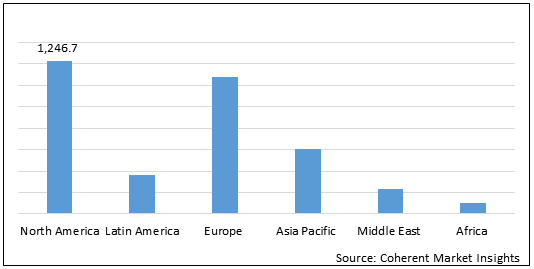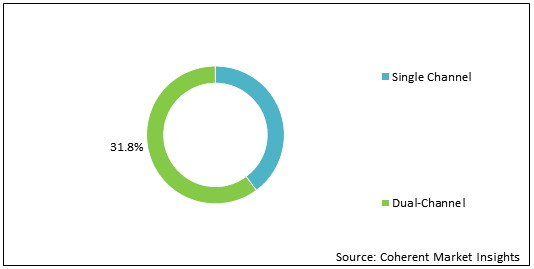Deep brain stimulation is a surgical procedure used for the management of motor function symptoms in patients suffering from various neurological disorders, such as essential tremor, Parkinson’s disease and dystonia, wherein drug therapy is not effective.
The global deep brain stimulation devices market for Parkinson’s disease is estimated to be valued at US$ 3,567.6 million in 2021 and is expected to exhibit a CAGR of 8.3 % over the forecast period (2021-2028).
Recent Developments:
Companies are launching new deep brain stimulation devices based on new and advanced technology which can be attributed to the growth of deep brain stimulation devices market for Parkinson’s disease. For instance, in January 2021, Medtronic plc. announced the first enrollment in Adaptive DBS Algorithm for Personalized Therapy in Parkinson's Disease (ADAPT-PD). The clinical trials are for testing the safety and efficacy of the Percept PC device which helps in automated adjustment of brain stimulation for providing therapy and management of symptoms associated with Parkinson's disease.
In addition, the technological advancements in deep brain stimulation devices is further boosting the market growth. For instance, in March 2021, University of Houston biomedical engineer presented evidence in Nature Communications Biology that stimulation of higher frequencies (>100Hz) can induce resonating waveforms for recalibration of dysfunctional circuits. This new technology can help in treatment of Parkinson’s disease.
North America held dominant position in the global deep brain stimulation devices market for Parkinson’s disease in 2020, accounting for 37.5% share in terms of volume, followed by Europe and Asia Pacific, respectively. The rapid adoption of new deep brain stimulation devices in the region can be attributed to the market growth. For instance, in June 2021, the University of Florida Health neurosurgeons implanted Medtronic’s SenSight Directional Lead System in Parkinson’s disease patient. It is a technologically advanced deep brain stimulation system for monitoring real-time brain signals.
Figure 1. Global Deep Brain Stimulation Devices Market for Parkinson’s Disease Value (US$ Mn), by Region, 2020

To learn more about this report, Download Free Sample
Global Deep Brain Stimulation Devices Market for Parkinson’s Disease: Drivers
Increasing prevalence of Parkinson’s disease is expected to propel growth of the global deep brain stimulation devices market for Parkinson’s disease over the forecast period. For instance, according to the study, ‘Prevalence of Parkinson’s disease (PD) across North America”, published in July 2018 in the journal Nature, the number of people suffering from PD is expected to reach 930,000 in 2020 and 1,238,000 in 2030.
Moreover, increasing geriatric population is also expected to aid in growth of the market. For instance, according to the U.S. Census Bureau, the U.S. geriatric population is expected to reach 77 million by 2034.
Deep Brain Stimulation Devices Market for Parkinson’s Disease Report Coverage
| Report Coverage | Details | ||
|---|---|---|---|
| Base Year: | 2020 | Market Size in 2021: | US$ 3,567.6 Mn |
| Historical Data for: | 2017 to 2020 | Forecast Period: | 2021 to 2028 |
| Forecast Period 2021 to 2028 CAGR: | 8.3% | 2028 Value Projection: | US$ 6,234.3 Mn |
| Geographies covered: |
|
||
| Segments covered: |
|
||
| Companies covered: |
Boston Scientific Corporation, MEDTRONIC, Inc., St Jude Medical, Inc., Sapiens Neuro, and Aleva Neurotherapeutics SA |
||
| Growth Drivers: |
|
||
| Restraints & Challenges: |
|
||
Uncover macros and micros vetted on 75+ parameters: Get instant access to report
Global Deep Brain Stimulation Devices Market for Parkinson’s Disease: Opportunities
Benefits of deep brain stimulation over other approaches is expected to offer lucrative growth opportunities for players in the global deep brain stimulation devices market for Parkinson’s disease. For instance, in June 2020, the study, ‘Deep Brain Stimulation in Early-Stage Parkinson’s Disease: Five Year Outcomes’, published in Neurology, reported that deep brain stimulation can decrease the risk for disease progression as well as the need for and complexity of medications in patients with early-stage Parkinson disease compared with optimal medical therapy alone.
Moreover, advances in electrode design of deep brain stimulation devices for Parkinson’s disease is also expected to aid in growth of the market. Use of high-resolution electrodes, thin-film technology, and other advances may allow the development of multi-contact electrodes, which can even be flexible if required.
Market Trends
Deep brain stimulation devices for Parkinson’s disease are vulnerable to electromagnetic interference. In May 2018, a study published in the Journal of Neurosurgery, researchers noted that deep brain stimulation devices used to treat neurological movement disorders such as Parkinson’s disease, are vulnerable to strong electromagnetic fields that are created by other electrical devices.
R&D in deep brain stimulation is expected to boost growth of the global deep brain stimulation devices market for Parkinson’s disease. For instance, in June 2020, the study, “The structural connectivity of subthalamic deep brain stimulation correlates with impulsivity in Parkinson’s,” published in the journal Brain, reported that distinct connections between nerve cells in the brain may explain the reason behind Parkinson’s disease patients developing impulsivity and behavioral problems after deep brain stimulation therapy.
Figure 2. Global Deep Brain Stimulation Devices Market for Parkinson’s Disease Share, By Product, 2020

To learn more about this report, Download Free Sample
Key Takeaways of the Graph:
Global Deep Brain Stimulation Devices Market for Parkinson’s Disease: Restraints
Excise tax on medical devices is expected to hinder growth of the global deep brain stimulation devices market for Parkinson’s disease. According to the Affordable Care Act in the U.S., an excise tax of 2.3% is imposed on importers and manufacturers of medical devices. This rise in cost is subsequently passed on to end customers that include patients seeking deep brain stimulation devices for Parkinson’s disease.
Moreover, use of deep brain stimulation is limited to highly refractory patients and conditions, typically in the context of expert multidisciplinary care and clinical research, which is also expected to limit the market growth.
Global Deep Brain Stimulation Devices Market for Parkinson’s Disease: Competitive Landscape
Major players operating in the global deep brain stimulation devices market for Parkinson’s disease include, Boston Scientific Corporation, MEDTRONIC, Inc., St Jude Medical, Inc., Sapiens Neuro, and Aleva Neurotherapeutics SA.
Global Deep Brain Stimulation Devices Market for Parkinson’s Disease: Key Developments
Major players in the market are focused on approval and launch of new products to expand their product portfolio. For instance, in December 2019, Aleva Neurotherapeutics received CE Mark for its flagship product, the directSTIMTM Deep Brain Stimulation System.
Share
Share
Missing comfort of reading report in your local language? Find your preferred language :
Transform your Strategy with Exclusive Trending Reports :
Frequently Asked Questions
Select a License Type
Joining thousands of companies around the world committed to making the Excellent Business Solutions.
View All Our Clients